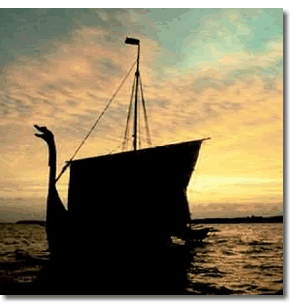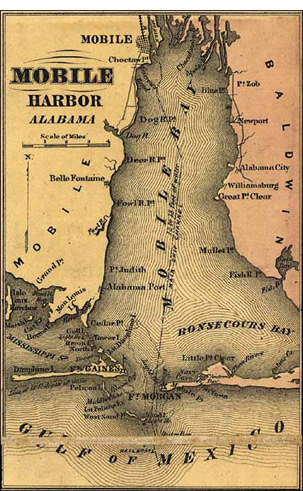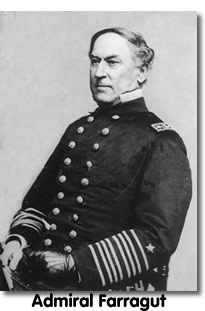Of Madoc and Monitors:
A Trip to Mobile Bay.
"Anno 1170, hee left his Country,
and after a long saile and no lesse patience,
blest, with some happy windes,
they discried land in the Gulph of Mexico,
not farre from Florida, a land affording health,
aire, gold, good water and plenty of Nature's blessings,
by which Prince Madoc was ouer-ioyed and had reason
to account his happy estate superior to his brothers."
— Sir Thomas Herbert,
A Relation of Some Yeares Travaile, Begvnne Anno 1626 (1634)
By Ron Fritze
February 5, 2008
The Alabama Humanities Foundation has a really neat program called Roads Scholars, which sends speakers out to various parts of the state to talk about humanities topics, often related to Alabama. The AHF and the community inviting the speaker split the costs of travel, lodging, and a modest stipend for the speaker. When I received the information about applying to be a Roads Scholar speaker, I decided to submit a proposal to be a speaker and was pleased when it was accepted. I had applied to speak about the myth of Prince Madoc and the Welsh colonization of America in 1170 along with the subsequent reports of Welsh Indians on the frontier.
The story of Prince Madoc has several variations. It starts in the year 1170. Prince Owen of Gwynned in Wales has died, leaving numerous legitimate and illegitimate sons by his various wives and mistresses. Several of these sons desire to succeed their father and a civil war breaks out. Madoc is one of the sons, most likely an illegitimate one. He does not aspire to become the Prince of Gwynned, but he does hope to live to a ripe old age.
Where Oh Where Did Prince Madoc Land?
Deciding to leave Wales, Madoc and some companions take to the sea and sail west. Eventually they reach an unknown but large landmass,
 which, as we know, was the Americas. There are various suggestions as to where they landed, ranging from Newfoundland to the mouth of the Amazon River. The three most popular locations cited by speculators are around Vera Cruz in Mexico, the mouth of the Mississippi River, and Mobile Bay. Those who advocate a landing at Vera Cruz assert that Madoc was probably the inspiration for the Mexican myths of the white god Quetzalcoatl.
which, as we know, was the Americas. There are various suggestions as to where they landed, ranging from Newfoundland to the mouth of the Amazon River. The three most popular locations cited by speculators are around Vera Cruz in Mexico, the mouth of the Mississippi River, and Mobile Bay. Those who advocate a landing at Vera Cruz assert that Madoc was probably the inspiration for the Mexican myths of the white god Quetzalcoatl.
Wherever it was that Madoc landed, he liked what he saw.
Leaving some of his companions behind to start a settlement, Madoc returns to Wales to recruit more colonists for the newly discovered land. Returning to America with a second expedition, he lands either at the mouth of the Mississippi or at Mobile Bay. Initially, the Welsh colonists think the new land is uninhabited, but soon after moving inland, they find that other people are already living there — and the original inhabitants are not at all happy about the arrival of the Welsh settlers.
The Pressure to Move Is Relentless.
According to the Mobile Bay version, the Welsh move north and settle in northern Alabama, northwestern Georgia, and southeastern Tennessee. Faced with hostile Native Americans, the Welsh build fortified settlements, the remnants of which are the Indian mounds we see today. Relentless pressure from the native tribes forces the Welsh to move again and again.
Eventually, so the story goes, they settle in the neighborhood of present-day Louisville, Kentucky. After living there in peace for a while, the Welsh colonists find themselves facing a great confederacy of the Native American tribes, which rises up and attacks them. A great battle takes place on Sand Island in the Ohio River, and the Welsh are defeated with the loss of many warriors. The survivors retreat westward down the Ohio, but at the confluence of the Ohio and the Mississippi, they turn north and follow the great river to the mouth of the Missouri River. From there they proceed up the Missouri until the reach the vicinity of present day Bismarck. At long last the Welsh settle down to become the original peoples of the Mandan tribe.
In the other version of the tale, where Madoc and his people landed at the mouth of the Mississippi, they are depicted as making their way inland along a more westerly route, but eventually the two versions merge at Louisville and become identical.
Can Anyone Find the Welsh Indians?
 The Madoc myth implied that descendants of the Welsh still might be alive somewhere in North America. The idea that the Mandans were originally Welsh developed later. Sighting of Welsh Indians began in the sixteenth century and continued into the early nineteenth century. Well over a dozen tribes were identified as descendants of the Welsh. One of the instructions that President Thomas Jefferson gave to Meriwether Lewis and William Clark was to look for Welsh Indians. They did not find any. Still, many people continue to believe the story of Madoc. It is almost too good not to be true.
The Madoc myth implied that descendants of the Welsh still might be alive somewhere in North America. The idea that the Mandans were originally Welsh developed later. Sighting of Welsh Indians began in the sixteenth century and continued into the early nineteenth century. Well over a dozen tribes were identified as descendants of the Welsh. One of the instructions that President Thomas Jefferson gave to Meriwether Lewis and William Clark was to look for Welsh Indians. They did not find any. Still, many people continue to believe the story of Madoc. It is almost too good not to be true.
There are several places in Alabama associated with stories of the medieval Welsh, including De Soto Falls at Fort Payne and Muscle Shoals on the Tennessee River. As a Roads Scholar, I have accepted invitations to speak at both Fort Payne and Florence, near Muscle Shoals. I would highly recommend visiting both places.
The Mound Museum in Florence is a fine little museum located right next to a rather large mound near the Tennessee River. In the past, the mound was an important ceremonial center. The museum itself possessed a wonderful display of arrowheads and projectile points, some of them from the Clovis culture.
Fort Payne: a Great Little Museum.
Fort Payne is home to the Depot Museum. It is a great little museum located in the old railroad depot, but this is not just any depot — it is one of those really fine examples of Victorian railroad architecture from the late nineteenth century. A nice collection of materials related to the history of Fort Payne and the surrounding area are on display. If you go up into the mountains, you can visit the De Soto Falls, which are also quite beautiful, although in this time of drought in the Southeast, they are sadly depleted of water flow. It is said that De Soto visited them — and Madoc, too.
Another important location for the Madoc myth in Alabama is Fort Morgan, which guards the entrance to Mobile Bay. As I've mentioned, some proponents of the myth of medieval Welsh colonization
 assert that Prince Madoc and his people first landed at Mobile Bay near the present day location of Fort Morgan. One of the great advocates of the Madoc legend in Alabama was a man named Hatchett Chandler (1882-1967). He was a native of Alabama, a sometime business man, and an amateur historian. Some time after the Second World War, Chandler talked the local chapter of the Daughters of the American Revolution into erecting a plaque commemorating the landing of Prince Madoc in 1170. Although his historical ideas were frequently problematic, Chandler led the effort to secure the preservation of Fort Morgan, which is an important landmark in Alabama and the focal point of one of the Civil War's more dramatic battles.
assert that Prince Madoc and his people first landed at Mobile Bay near the present day location of Fort Morgan. One of the great advocates of the Madoc legend in Alabama was a man named Hatchett Chandler (1882-1967). He was a native of Alabama, a sometime business man, and an amateur historian. Some time after the Second World War, Chandler talked the local chapter of the Daughters of the American Revolution into erecting a plaque commemorating the landing of Prince Madoc in 1170. Although his historical ideas were frequently problematic, Chandler led the effort to secure the preservation of Fort Morgan, which is an important landmark in Alabama and the focal point of one of the Civil War's more dramatic battles.
In Time for the Oysters and Crabs.
The people at the Gulf Shores Tourism Bureau invited me in January to come down and speak at their Adult Activity Center. Once again, Twylia and I were on the road to Gulf Shores. For those of you not familiar with Alabama, where we live in Athens is about as far away from Gulf Shores as you can get in this state. It is a 360-mile drive, but almost all of it is via interstate, so it is not a bad drive. My lecture was scheduled for 10 a.m. on Friday, 18 January 2008, but they wanted me there by about 9:15 to share early coffee and conversation. We drove down the day before, got our motel room (the place allows pets, so we may be going back down with one or more of the dogs), and got some great seafood at the Original Oyster House.
 As a vacation town, Gulf Shores has lots of places
As a vacation town, Gulf Shores has lots of places
to eat, most of them quite good. Prior to going to Gulf Shores, many people gave us recommendations about where to eat, but the only restaurant that was mentioned more than once was the Original Oyster House, which was mentioned five times. We decided to check it out — and thoroughly enjoyed our meal. I ordered fried oysters, sautéed shrimp scampi, and stuffed crabs — all very good, but the stuffed crabs were especially tasty.
The next morning we made it to the Adult Activity Center and met several folks who had come for the lecture. At ten, I began my talk, well aware from casual chats and snippets of overheard conversations that I would be speaking to an audience already more than a little familiar with Madoc and the Welsh. I was a little worried that my lecture might be old hat to many of those in attendance, but during the lecture, the auspicious body language and affirmative head nodding of the listeners allayed those worries. At the end, I got a number of good questions. Several people stopped and talked as the meeting was breaking up.
Let's Give 'em the Warm Fuzzies,
Mimimal Reading, and Easy Grading
For those among my readers who are accustomed to teaching the 18 to 22-year-old traditional student, you can probably relate to my occasional feeling that I've either turned into a very boring lecturer, or have aged into an old fogey. These days, teaching undergraduates of the traditional age group, particularly freshman and sophomores, often degenerates into providing warm fuzzies, assigning minimal amounts of reading, and a maximizing of easy grading. It is a proven formula to high student evaluation numbers.
Of course, there are some academic administrators who regard the numbers generated by student evaluations as if they were written by the finger of God on Mount Sinai and handed down as gospel to separate good instructors from bad. This approach is a sign of an administrator who is lazy and who also avoids having their own teaching evaluated, if they teach at all. But I digress. Let me just say this: If you give an organized lecture on the right topic, with a good delivery, to an older, educated audience, you will soon discover that you are interesting, not boring, and smart, not dull — that you are actually someone the audience members want to talk with and learn more from. Be still my heart! Lecturing to an older, educated, and interested audience restoreth your soul as a teacher.
In case you don't know it, ten miles north of Gulf Shores is the town of Foley, home to the Tanger Outlet Mall, a true outlet mall with many good bargains. That is where Twylia wanted to go. I dropped her off, headed back to Gulf Shores, and had a pleasant lunch with some of the people from my lecture who had invited me to join them. They knew of a good place called King Neptune, which features a weekly menu of inexpensive but good lunch specials. I chose Shepherd's Pie with sides of vegetables — it was a nicely done Shepherd's Pie, too. I thoroughly enjoyed an entertaining lunch, and when it was over, I got in the car and drove the twenty miles to Fort Morgan. I had visited the site once before, perhaps fifteen years in the past, but being this close again, I could not pass up visiting the place again.
I Had the Fort All to Myself.
The day started out sunny, but after lunch the sky turned cloudy and the air grew cooler. I had a good jacket, so it was just fine for climbing around an old fort. To my delight I had the fort all to myself until the very end of my tour when two couples arrived. Fort Morgan is in substantially the same condition as it was in 1864 when the Battle of Mobile Bay raged near the end of the Civil War. Built in the 1830s, the fort was upgraded during World War I and prior to World War II to provide platforms for more modern cannons. It is a typical star-shaped structure surrounded by glacis to protect it from enemy cannon fire.
Fort Morgan protected the shipping channel at the entrance to Mobile Bay. In 1864, Mobile, Alabama, was one of the few ports of the Confederacy that had not fallen to the Union Navy. But Rear Admiral David Farragut
 was interested in changing that situation. He had long placed the capture of Mobile at the top of his list of goals. Mobile, however, was protected not only by Fort Morgan, but also by several lesser forts and batteries, the fearsome ironclad Tennessee, and some small gunboats. The channel was also obstructed by a triple row of floating mines placed to direct enemy ships into the guns of Fort Morgan and the Tennessee.
was interested in changing that situation. He had long placed the capture of Mobile at the top of his list of goals. Mobile, however, was protected not only by Fort Morgan, but also by several lesser forts and batteries, the fearsome ironclad Tennessee, and some small gunboats. The channel was also obstructed by a triple row of floating mines placed to direct enemy ships into the guns of Fort Morgan and the Tennessee.
Admiral Farragut gathered a powerful fleet and a substantial force of troops to land and capture Mobile and its forts. Besides the wooden steam frigates, Farragut also had four monitors in his fleet. The monitors were heavily armored with large cannons mounted in rotating gun turrets. Some of the monitors had one turret, others had two.
Farragut Sails into Battle on the Hartford.
On 9 August 1864, the Union Navy began its assault. The ships approached Fort Morgan in a double line with the monitors in the line closest to Fort Morgan. The line of the wooden frigates was on the outside with the Brooklyn in the lead, followed by Farragut's flagship the Hartford. When the Union vessels came into range, they began to exchange fire with Fort Morgan.
Entering the channel, they began to approach the Tennessee and its escorts. The lead monitor, Tecumseh, was ordered to engage the Tennessee, and its commander, Tunis Craven, was determined to do just that. Unfortunately he steered his ship across the mine field, where it struck a mine and quickly sank, drowning Craven and most of his crew in just a few minutes. The death of the Tecumseh caused the captain of the Brooklyn to lose his nerve. He stopped his ship, halting the frigates' line of battle under the guns of Fort Morgan. Farragut wanted the Brooklyn to keep moving, but seeing that it was not going to move, the Admiral ordered the Hartford to sail around the Brooklyn and across the deadly minefield with the other ships behind him to follow.
Did the Admiral Really Say It?
Victory or defeat hung in the balance for the Union forces. It was at this point that Farragut supposedly barked out, "Damn the torpedoes! Full speed ahead!" No one in earshot of Farragut that day would later admit to having heard the Admiral utter those exact words — although, in good sailor fashion, Farragut during the heat of the battle surely damned one thing or another a goodly number of times.
Farragut's gamble paid off. He knew that mines frequently became water logged and would not explode. He took a calculated risk, crossing the minefield — and it turned out alright for him and his fleet. The Hartford and the rest of the fleet safely crossed the minefield, although they could hear the mines bumping on the hulls of their ships.
The Union fleet then regrouped while the Tennessee took refuge under the guns of Fort Morgan. Its commander, perhaps emboldened by the earlier sinking of the Tecumseh, decided he just had to engage the Union warships in battle. Out came the Tennessee to fight. The unwieldy Confederate vessel was quickly surrounded by Farragut's armada. Wooden ships rammed it three times without inflicting serious damage. But the monitors closed in, their big cannons blazing, and gave the Tennessee a severe pounding that knocked out many of its guns and destroyed its ability to steer.
The helpless Tennessee was forced to surrender, leaving the city of Mobile virtually without defenses. Farragut had triumphed.
Afterward, when the Confederate minefield was cleared, it turned out that ninety percent of the mines had become water logged. The Tecumseh had the bad luck the strike one of the few remaining live mines, but the rest of the fleet did not. Now when you visit Fort Morgan, there is a red buoy in the ship channel that marks where the Tecumseh went down.
How Wondrous the Eye of Imagination.
Standing on the ramparts of the fort on a mild winter's day in 2008, a person with an imagination and an eye toward history can't avoid wondering what it must have been like to have been there on that violent summer day in 1864, either on a ship caught up in the smoke and splash of the naval battle, or high above in Fort Morgan with the cannons booming. Meanwhile, poor Prince Madoc's plaque is relegated to a storage shelf, no longer on display in the Fort Morgan museum. The park service staff are apparently a bit embarrassed by it, which is too bad. While the plaque commemorates a non-event of pseudohistory, it is also a fascinating artifact of local folklore.
Click on the black panther to read Ron Fritze's previous essay,
"George MacDonald Fraser and Sir Harry Paget Flashman."
|

|




